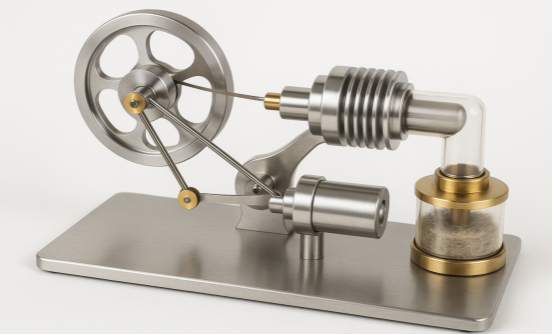
Can a Stirling Engine Run on Cold?
An engine is a lifeline to any related equipment, they are used for various mechanical purposes and have been titled as a great invention of mankind. Amongst the famous engine types, the Stirling Engine stands out at the top, featuring a remarkable performance.
When we think about engines, we usually associate them with heat-burning fuel, rising temperatures, and steam. But what if we asked: Can a Stirling engine run on cold?
In this guide, we will write about the Stirling Engine, its features, applications, and why "cold" can sometimes bring power.

Understanding the Stirling Engine
The invention of Stirling Engines takes us back to the 18th century. It was first invented in 1816 by a Scottish engineer, Reverend Robert Stirling. Afterward, it was officially declared a commercial engine type in the 19th century. Then the journey begins and successfully reaches the passing 21st century.
A Stirling engine is a type of heat engine that operates by cyclic compression and expansion of a working gas at different temperatures.
Unlike internal combustion engines, it does not burn fuel internally. Instead, it relies on an external temperature difference—between a hot side and a cold side.
How does a Stirling Engine work?
A Stirling Engine relies on 4 working cycles.
a: Isothermal Expansion: When gas gets warm, it expands and pushes the cold piston.
b: Isochoric Heat Transfer: The hot gas moves towards the cold cylinder from the hot cylinder.
c: Isothermal Compression: In this phase, the expanded gas contracts and releases energy.
d: Isochoric Heat Transfer: The gas moves back towards the hot end and repeats the process.

Key Features of a Stirling Engine
· A Stirling Engine performs quietly and efficiently.
· A Stirling Engine features lower emissions of harmful gases.
· A Stirling Engine can utilize any external heat source, including solar and fire.
· A Stirling Engine works efficiently between the hot and cold ends.
· Stirling Engine's operations are compatible with various environments, like underwater, on land, and in the sky.
Measuring Formula
η = 1−T cold/T hot
Here, "T cold" & "T hot" are in Kelvin.
Measuring results becomes more efficient with a greater temperature difference.

Can a Stirling Engine Run on Cold?
There are various misconceptions regarding a Stirling Engine running on cold. Because the main operational definition of this engine lies between the temperature difference of the hot and cold sides. But in reality, it's a big "Yes" that a Stirling Engine can run on cold.
Following this mechanism, one side of the cylinder remains at ambient temperature, and the other side is cold. Here, the Stirling Engine starts functioning even in cold weather. Moreover, the Stirling Engine can operate in severe cold places, including Antarctica.
By comparing the Stirling Engine in cold and normal environments, it is proven that the engine can operate efficiently in both conditions. The only noted difference is utilizing the hot and cold sides vs the ambient temperature side and the cold side of the cylinder.

Practical Examples
Below are some practical examples regarding the low-temperature operations of a Stirling Engine.
· Ice Blocks (Room Temp - Ice): If we place one side of the Stirling Engine on ice cubes or bars and keep the other side at ambient temperature. One side of the cylinder will act as a heat sink, and the other will produce and transfer heat to the sink. In this way, the engine will start operating in cold weather.
· Liquid Nitrogen (Room Temp - Nitrogen): Here, one side of the Stirling Engine is placed over the liquid nitrogen, and the other side is kept at normal temperature. Again, it creates a temperature difference between the two sides, and the engine starts running by producing and transferring the heat.
· Solar Power (Ice - Solar Heat): In this example, one side of the Stirling Engine utilizes ice, and the other side utilizes solar heat. So, a required amount of heat and cold is produced at both ends. Finally, the engine becomes able to start working.
The other examples include the same mechanism, following one side cooler than the other. It solely depends on the type of environment and weather conditions. The Stirling Engine will undoubtedly work in any cold environment.
Key Challenges
· Sometimes, Stirling Engines running in a cold environment may result in producing low power or energy. High-level operations may get impacted if not managed accordingly.
· A Stirling Engine running on cold may require a proper schedule to refill the cold sources in order to avoid any disruption in the operations.
· Following the operational pattern in a cold climate, the cost of operation may be high due to the arrangement of various cold sources, including ice and liquid nitrogen.
· A high amount of moisture in a cold environment can cause wear and tear to engine parts and their overall performance.
Applications & Future Trends of the Stirling Engine on Cold
Educational Purposes
Students and DIY enthusiasts perform experiments with Stirling Engines to accurately measure temperature differences and other findings.
Polar Research Stations
In extreme cold weather conditions, the Stirling Engine is used with one side cold and the other side hot to power the equipment.
Space Missions
The space missions also include the contribution of the Stirling Engine, where the outer cylinder acts as a heat sink and the inner cylinder produces heat.
Solar-Ice Hybrid Generators
Similarly, the Stirling Engine contributes to power hybrid generators utilizing solar power on one end and a cold source on the other end.
Waste Heat Recovery
In cold climates, the Stirling Engine utilizes heat from sources like exhaust fans, industrial machinery, and others. It is then utilized with cold ambient air to operate accordingly.

EngineDiy Products
When it comes to high-end products and services, we rank among the top platforms selling engines and other related accessories worldwide. You read it right! EngineDiy has been serving the market for 15 years, maintaining a positive reputation and long-term clients who buy our top-quality engines.
Businesses, Consumers, Students, and DIY Enthusiasts can approach us with their relevant queries and demands. Our customer support team is working 24/7 to assist our valuable customers. We offer discounted prices to bulk buyers and limited-time deals on different products and services.
Closing Remarks
We can never underestimate the importance of the Stirling Engine; it's a great invention of its time and still contributes to multiple departments where required.
Without any hesitation, it can be concluded that a Stirling Engine can run efficiently in a cold climate. One end of the cylinder must be on a cold surface, and the other end at normal temperature, producing heat. The Stirling Engines are quiet, efficient performers, and reliable mechanical supporters.
Don't forget to visit our stirling engine kit page if you really want to make your lab experience more amazing. Stay in touch with us for more informative blog posts.
FAQs
Q1: How much of a temperature difference is required for the Stirling Engine to operate?
It depends on the engine design. For low-temperature-difference (LTD) models, a difference as small as 20–30°C (293K–313K) may be enough to start slow rotation.
However, for efficient and continuous operation, a larger difference—up to 200–400K—is ideal.
Q2: What does “running on cold” actually mean for a Stirling Engine?
It means placing one side of the engine on a cold surface (like ice or liquid nitrogen) while the other side is exposed to a warmer environment (like room temperature).
The engine isn’t powered by “cold” itself—it is powered by the temperature difference between hot and cold.
Q3: Will it work to use a Stirling Engine inside the room on ice?
Yes, in principle. For example, in the Arctic or at night in deserts, you can harvest energy from natural temperature differences between cold air and stored heat.
However, practical applications often require optimized design and insulation to maintain the temperature gradient.

Leave a comment